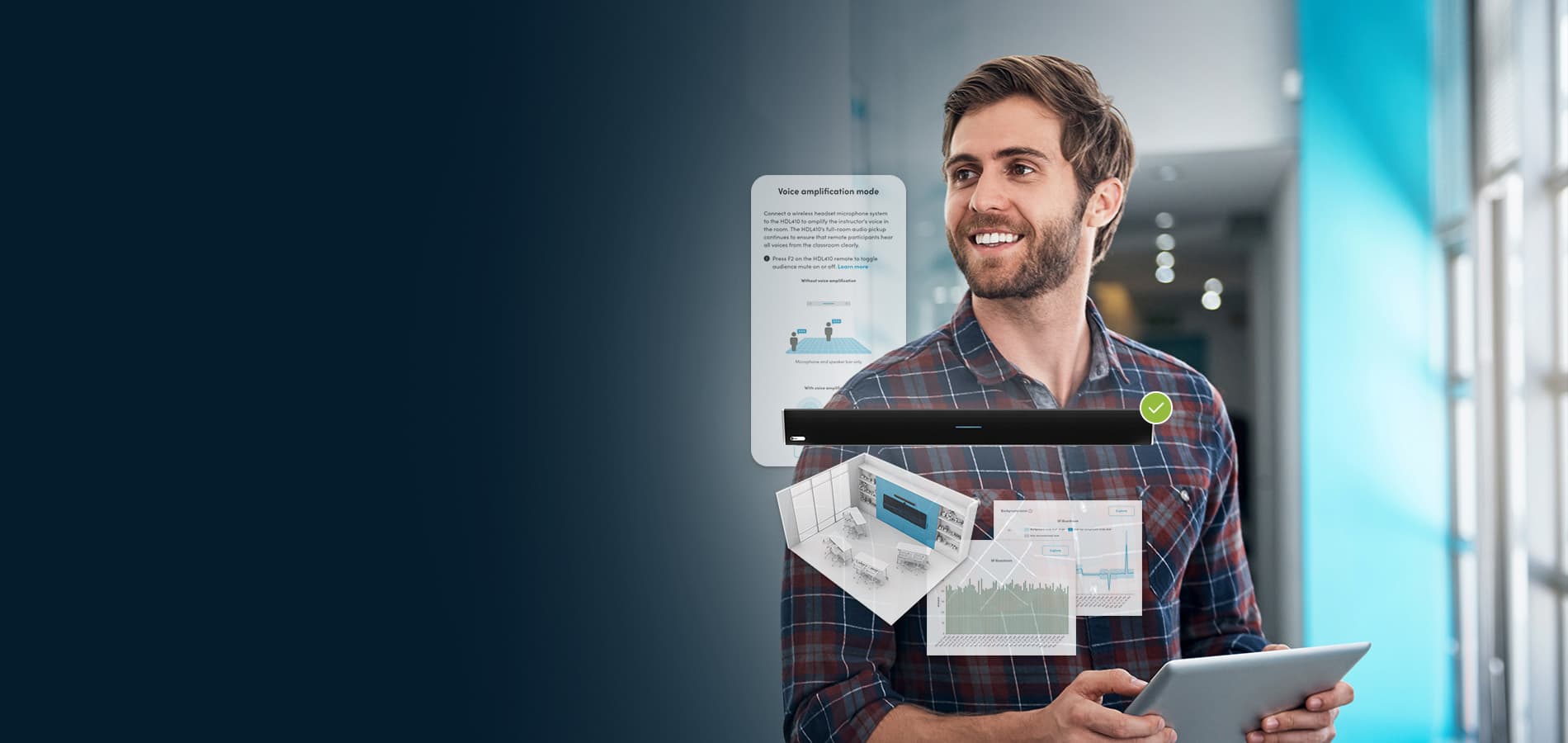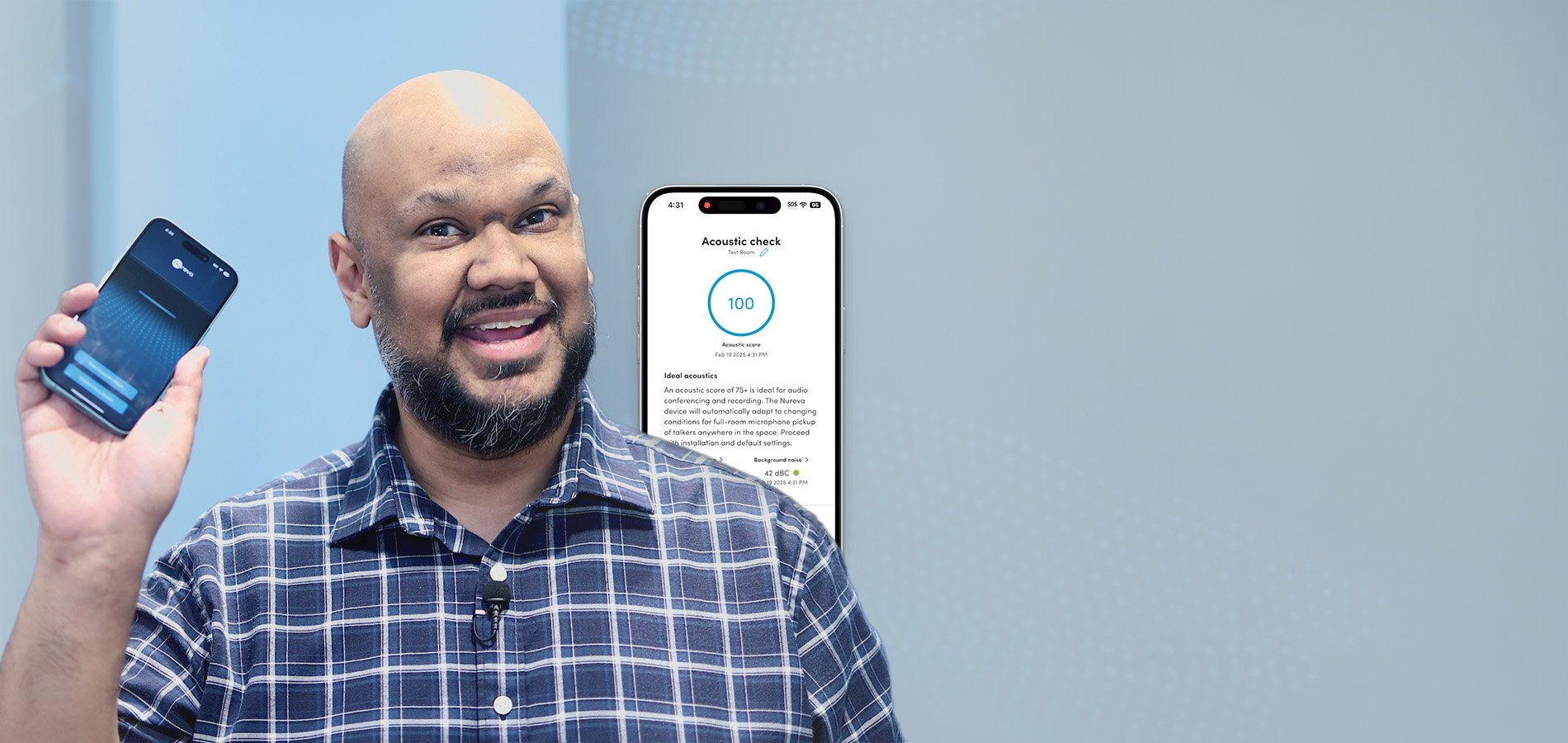









PRODUCTS / HDL series / HDL200
HDL200
Audio conferencing for medium-sized rooms up to 18' x 18'
$1,099* US pricing
- Integrated microphone and speaker bar
- Wall mounting bracket
- Cable routing channel
- Country-specific power cable
- USB Type A-B cable
- Infrared remote
- Nureva® Console (cloud-based management and monitoring)
- Nureva App (setup, optimizing and customizing)
- Nureva Developer Toolkit (local and cloud-based APIs)
- Nureva Pro 2-year service plan (value-added services and support)
Microphones
10 low-noise omnidirectional MEMS
Frequency response at 94 dB SPL 100 Hz to 7 kHz
Total harmonic distortion (THD) at 94 dB SPL: 0.25% (typical)
Speakers
2 x 20 W 3.25" high-fidelity full range
Frequency response: 125–20,000 Hz
Interfaces
USB 2.0 interface to computer, type BInput jack for power supply
OPERATING
System requirements
Windows® 10 and 11
Power
Power rating: universal switching 100–240 V AC, 50–60 Hz
Power consumption: <25 W
Environmental
Operating temperature: 0° C to 40° C (32° F to 104° F)Storage temperature: -20° C to 70° C (-4° F to 158° F), humidity 5–90% (noncondensing)
DIMENSIONS
HDL200
Width: 46.4" (117.9 cm)
Height: 4.8" (12.2 cm)
Depth: 3.6" (9.1 cm)
Weight: 10.0 lb. (4.5 kg)
Shipping
Width: 48.0" (121.9 cm)
Height: 10.0" (25.4 cm)
Depth: 5.6" (14.2 cm)
Weight: 17.0 lb. (7.7 kg)
Warranty
Integrated microphone and speaker bar — standard 2-year limited hardware
Accessories and cables — 30 days
Extended warranties are available through Nureva Pro subscriptions
Part numbers
Dark: HDL200-B
Light: HDL200-W
Nureva Pro extension (1 year): NP-1Y
Nureva Pro extension (2 years): NP-2Y
Nureva Pro extension (3 years): NP-3Y
Optional accessories
Camera mount: CM-HDL200Display mount: DM-HDL200
Plug and play compatibility with all leading UC&C platforms, including Microsoft® Teams, Zoom, Google Meet™, GoTo Meeting and Cisco Webex®.
Integrates seamlessly with a wide variety of cameras, displays and lecture capture systems and other room peripherals.
Find our resources, downloads and software, or connect with our support team for more assistance.
Audio that gives you options
Choose the groundbreaking microphone and speaker bar that delivers great audio conferencing in your medium-sized rooms. The HDL200 system picks up every voice in spaces up to 18' x 18' (5.5 x 5.5 m). You can pair it with any camera, so you have more options for your setup.

Key features

Powerful solution
Go beyond typical all-in-one conferencing solutions with a system that delivers great audio in every inch of a space. You get fantastic mic pickup and speaker output — with management tools included.

Flexible installation
Install the HDL200 on a wall or display in as little as 30 minutes — no specialized skills or tools required. Avoid the annoyance of tabletop clutter and the hassles of an invasive ceiling installation.

Camera options
Choose your own camera and place it anywhere in the room. Or easily attach it to your HDL200 with an optional magnetic mounting bracket.

Plug and play
Enjoy the convenience of a USB plug and play device. The HDL200 can connect easily to your in-room computer and works well with all your other room peripherals.

Management tools
Use our software and services to make everything easier — with fleet management and monitoring tools, a handy setup app, versatile APIs and a service plan. And everything comes at no extra charge.
Integrations
The HDL200 works seamlessly with all leading UC&C platforms, including Microsoft Teams and Zoom. It also integrates with many room peripherals, such as cameras, displays and controllers.
Buy with confidence
Make your audio decisions your way: Hear us live online. Talk to an audio expert — not a salesperson. Ask about an on-site evaluation. Get purchasing information.

Software and services
Your HDL200 includes software and services designed to help you manage a large number of rooms for less. You get cloud-based management and monitoring, an intuitive setup app, developer APIs and a 2-year subscription to our service plan — at no extra charge.

Acoustic check
Get your room’s audio report card
Want to know the acoustic characteristics of your spaces? Want it to be easy — with no technician required?
Available with the Nureva® App, our free acoustic check feature lets you use your iPhone® or iPad® to measure background noise and reverberation in any space.
Resources
HDL200 system data sheet
Learn about the features and specifications of our audio system for medium-sized rooms.
Meet the HDL200
Discover how the HDL200 audio system delivers flexibility and performance to customers.
Demo on demand
Hear how the HDL200 handles cross talk — two or more people in a room talking at once.
Microphone Mist™ technology
See how thousands of virtual mics ensure every voice is picked up, thanks to our patented tech.
Wall-mount installation
Get simple instructions on how to install the HDL200 system on a wall in as little as 30 minutes.
Display-mount installation
Get simple instructions on how to install the HDL200 system on a display in as little as 30 minutes.
Specifications
HDL200
Technology features
Powerful onboard system processors
Continuous autocalibration
Position-based gain control
Acoustic echo cancellation
Built-in sound masking
Primary audio source for video playback
Integrated full-color display
Microphones
10 low-noise omnidirectional MEMS
Frequency response at 94 dB SPL 100 Hz to 7 kHz
Total harmonic distortion (THD) at 94 dB SPL: 0.25% (typical)
Speakers
2 x 20 W 3.25" high-fidelity full range
Frequency response: 125–20,000 Hz
INTERFACES
USB 2.0 interface to computer, type B
Input jack for power supply
INTEROPERABILITY
Plug and play compatibility with UC&C platforms including Microsoft Teams, Zoom, Google MeetTM, GoTo Meeting, Cisco Webex®, BlueJeans, Lifesize®, RingCentral MeetingsTM and more
Easy integration with third-party solutions such as cameras, displays and lecture capture systems
OPERATING
System requirements
Windows 10 and 11
Power
Power rating: universal switching 100–240 V AC, 50–60 Hz
Power consumption: <25 W
Environmental
Operating temperature: 0° C to 40° C
(32° F to 104° F)
Storage temperature: -20° C to 70° C (-4° F to 158° F), humidity 5–90% (noncondensing)
MANAGEABILITY
Automatic device updates
Remote management features available through cloud-based Nureva Console
CERTIFICATIONS AND COMPATIBILITY
Electromagnetic
FCC Part 15, Class A; ICES-003, Class A; CISPR 32 (EN 55032), Class A; CISPR 35 (EN 55035); CISPR 24 (EN 55024)
Safety
UL 62368; CAN/CSA-C22.2 NO.62368; IEC/EN 62368; AS/NZS 62368; UL 60950; CAN/CSA-C22.2 NO.60950; IEC/EN 60950; AS/NZS 60950
Compliance
RoHS, REACH, POPs (Persistent Organic Pollutants), WEEE, California Proposition 65, EPA (TSCA — Toxic Substances Control Act) Restrictions
DIMENSIONS
HDL200
Width: 46.4" (117.9 cm)
Height: 4.8" (12.2 cm)
Depth: 3.6" (9.1 cm)
Weight: 10.0 lb. (4.5 kg)
Shipping
Width: 48.0" (121.9 cm)
Height: 10.0" (25.4 cm)
Depth: 5.6" (14.2 cm)
Weight: 17.0 lb. (7.7 kg)
INCLUDES
Integrated microphone and speaker bar
Wall mounting bracket
Cable routing channel
Country-specific, power cable 6' (2.5 m), black
USB Type A-B cable, 10' (3 m), VW-1 rated, black
Infrared remote with 2 AAA batteries
Documentation
WARRANTY
Integrated microphone and speaker bar — standard 2-year limited hardware
Accessories and cables — 30 days
Extended warranties are available through Nureva Pro subscriptions
PART NUMBERS
Dark: HDL200-B
Light: HDL200-W
Nureva Pro extension (1 year): NP-1Y
Nureva Pro extension (2 years): NP-2Y
Nureva Pro extension (3 years): NP-3Y
Optional accessories
Camera mount: CM-HDL200
Display mount: DM-HDL200
Support
Find our resources, downloads and software, or connect with our support team for more assistance.
Full-room mic pickup
Our Microphone Mist™ technology fills medium-sized spaces with thousands of virtual microphones, so there’s always one nearby. People in the room can be confident they’ll always be heard by those who are remote.
Continuous autocalibration
There’s no need to calibrate your HDL200 manually. It’s always adapting to changes in your room’s acoustic profile, so even if you adjust the furniture or layout, the audio will still sound great.
Intelligent Sound Targeting
HVAC and other unwanted sounds can seriously affect your audio performance. So, instead of trying to suppress these noises after the fact, we use adaptive learning algorithms to preemptively ignore them.
Rapid conversation tracking
Our technology quickly switches pickup from talker to talker, no matter where they are in the room. Conversations sound natural, even when multiple voices overlap.
Position-based gain control
We apply gain separately to each sound in a space based on its position, creating a smooth and natural listening experience for remote participants.

HDL SERIES
Equip your medium and large spaces with flexible audio conferencing for less. Our HDL series delivers true full-room mic pickup in economical systems that are simple to install, use and maintain, making them easy to deploy at scale.
Optional add-ons
Don’t see a time that works? Find a different time






















